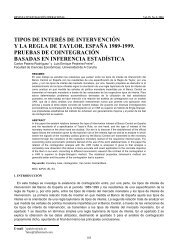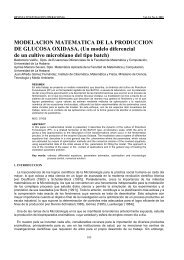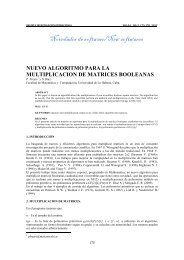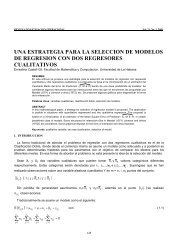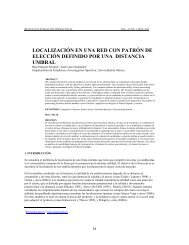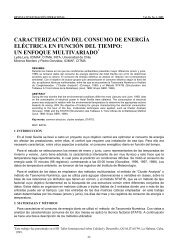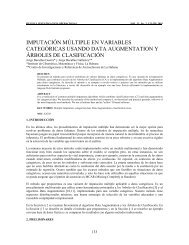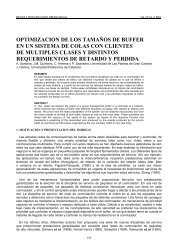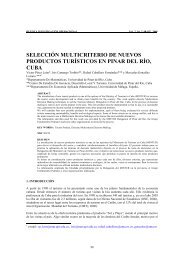numero de condicion y determinante de una matriz - revista ...
numero de condicion y determinante de una matriz - revista ...
numero de condicion y determinante de una matriz - revista ...
You also want an ePaper? Increase the reach of your titles
YUMPU automatically turns print PDFs into web optimized ePapers that Google loves.
A T ⎡ −7<br />
10<br />
⎢ −7<br />
= ⎢ 10<br />
⎢<br />
⎣<br />
− 3 ⋅10<br />
−14<br />
−10<br />
10<br />
0<br />
−7<br />
−14<br />
−10<br />
10<br />
0<br />
−7<br />
−14<br />
⎤<br />
⎥<br />
⎥<br />
⎥<br />
⎦<br />
Entonces, por (3), aplicando a<strong>de</strong>más (10) y (18):<br />
1<br />
−<br />
|| A ||<br />
∞<br />
= 10 14 ⋅ 2⋅10 -7 = 2⋅10 7<br />
Sustituyendo el resultado anterior y (19) en (1) se tiene finalmente que<br />
cond(A) ≈ 2⋅10 7<br />
De acuerdo con la <strong>de</strong>finición, esta <strong>matriz</strong> no es mal a<strong>condicion</strong>ada con respecto a la precisión utilizada,<br />
pues cond(A) es mucho menor que 10 14 . Si nuestra precisión fuera <strong>de</strong> 7 cifras, entonces sí lo sería.<br />
Conclusión 2: El <strong>de</strong>terminante <strong>de</strong> <strong>una</strong> <strong>matriz</strong> pue<strong>de</strong> ser relativamente pequeño, pero esta no ser mal<br />
a<strong>condicion</strong>ada con respecto a la precisión utilizada.<br />
Resumiendo en general, po<strong>de</strong>mos <strong>de</strong>cir que <strong>de</strong> acuerdo con (4), existe <strong>una</strong> relación entre número <strong>de</strong><br />
condición y <strong>de</strong>terminante <strong>de</strong> <strong>una</strong> <strong>matriz</strong>, pero que el hecho <strong>de</strong> que este último sea relativamente pequeño no<br />
implica que la <strong>matriz</strong> sea mal a<strong>condicion</strong>ada con respecto a la precisión utilizada, y viceversa.<br />
Faltaría analizar ahora qué problemas computacionales se presentan al resolver sistemas lineales mal<br />
a<strong>condicion</strong>ados y sistemas con matrices cuyos <strong>de</strong>terminantes sean pequeños. Esto podría ser objetivo <strong>de</strong> un<br />
trabajo futuro.<br />
REFERENCIAS<br />
[1] CONTE, S.D. and C. <strong>de</strong> BOOR: Elementary Numerical Analysis, an algorithmic approach,<br />
Third edition.<br />
[2] FORSYTHE, G.; M. MALCOLM and C. MOLER (1972): Computer Methods for Mathematical<br />
Computations, Computer Science Department, Stanford University.<br />
[3] HADLEY, G. (1968): Linear algebra, Ciencia y técnica.<br />
[4] SUAREZ, M. (1980): Matemática numérica, Editorial <strong>de</strong> libros para la educación.<br />
[5] VOLKOV, E.A. (1990): Métodos numéricos, Editorial MIR, Moscú.<br />
[6] WILKINSON, J.H. and C. REINSCH (1971): Linear Algebra, Springer-Verlag.<br />
34



